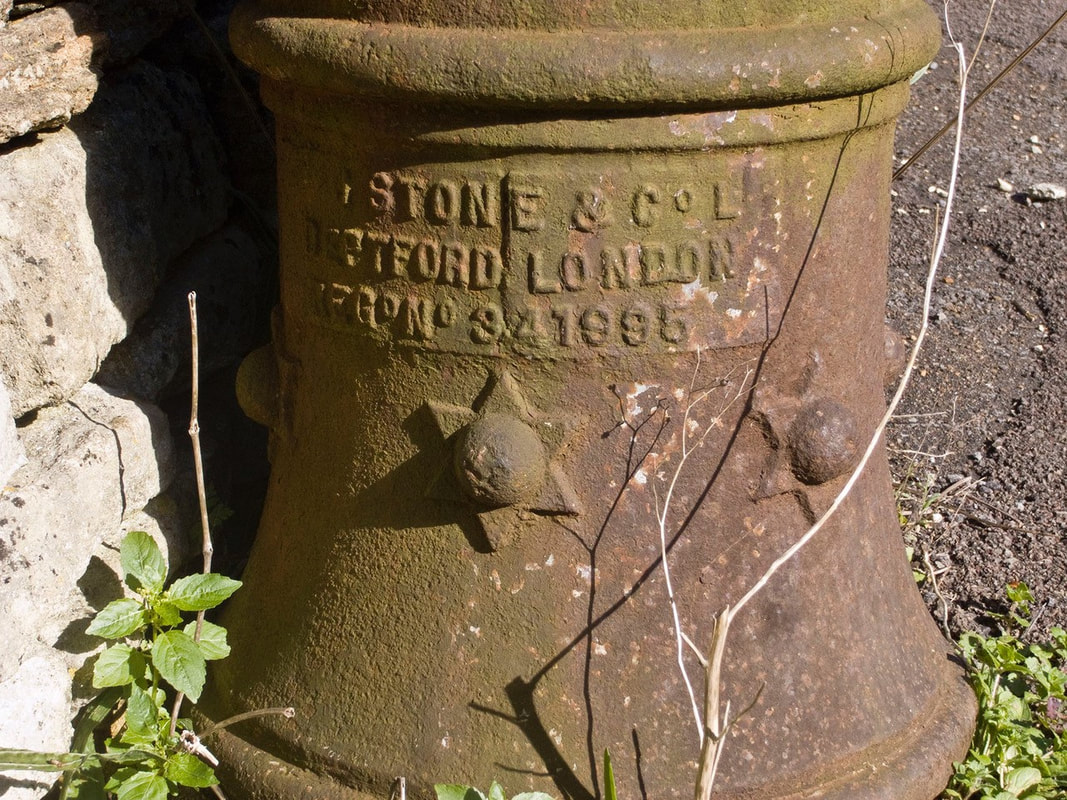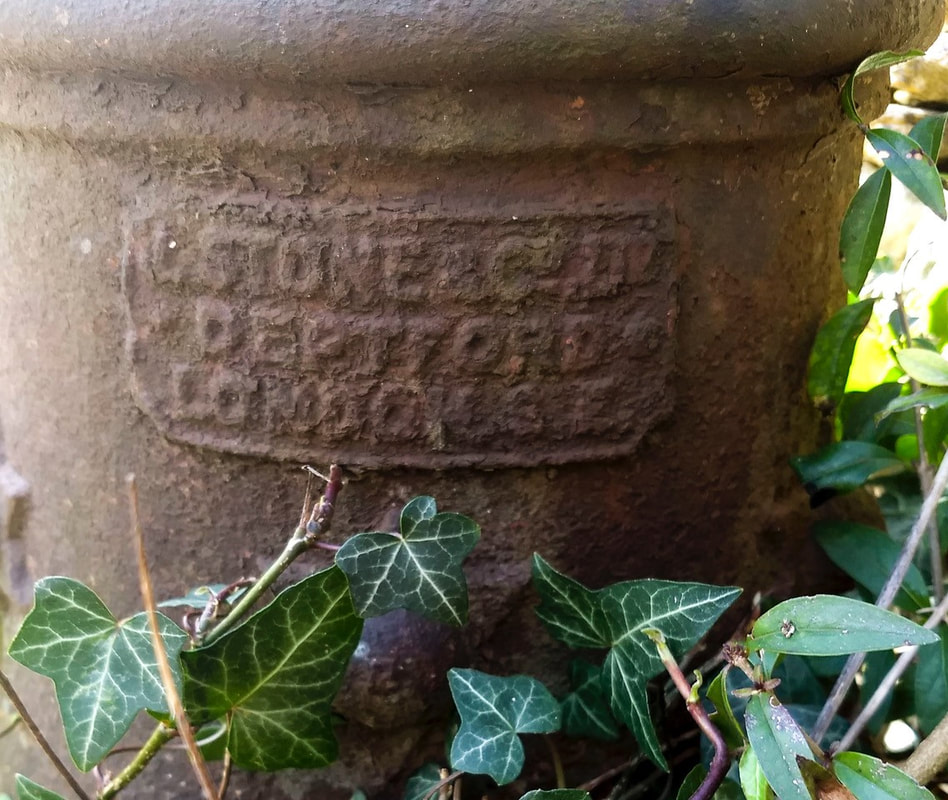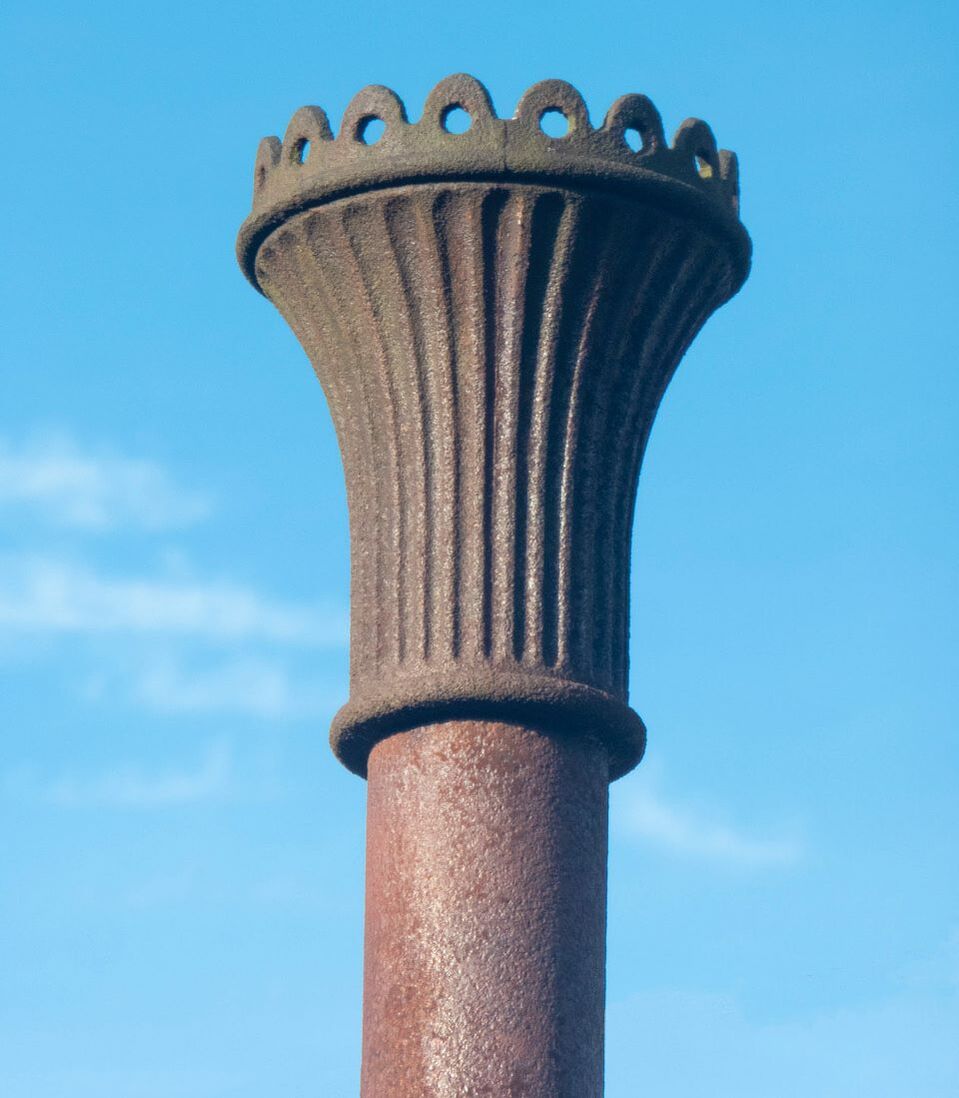|
Sewage Ventilation Stack:
Not a Gas Lamp Text and photos Jonathan Parkhouse December 2019 The intriguing and elegant iron column described as a Gas Lamp in the last issue of the website has intrigued me for a long time. It is a Grade II Listed structure. The 2001 listing description identifies it as a sewage ventilation stack, and goes on to assert that it is dated 1886, and that the [single] inscription on the base has the maker’s name and date:[1] Sewage ventilation stack. Dated 1886; made by J. Stone and Co. Ltd. of Deptford, London. Cast-iron. Moulded fluted pedestal with inscription on base with maker's name and date, tall plain shaft and flared top with pierced cresting. |
There are in fact two inscriptions on the base of the column, but neither is dated. I took a photograph of the larger inscription on the downslope side in October 2012 in fairly fortuitous lighting conditions; as you can see the inscription reads
J STONE & Co L
DEPTFORD LONDON
REGD NO 341995 [or possibly 941995 ]
J STONE & Co L
DEPTFORD LONDON
REGD NO 341995 [or possibly 941995 ]
|
The other inscription on the upslope side of the base (photographed in October 2019 in less favourable lighting) is shorter, but set within a rectangular border with scalloped corners:
J STONE & CO LTD ●DEPTFORD● LONDON.S.E. Thus, the dating of the column to 1886 is erroneous; the numerals on the base are not a four-digit date but part of a six-figure sequence. Whilst the overall decoration is not necessarily incompatible with a late nineteenth century date, the 1886 date is not supported by the inscriptions and there is no evidence for any date elsewhere on the structure. |
Perusal of the National Archives website reveals that a Registered Design number 341995, of 27th October 1879, was in respect of paper hangings, and registered to James Brown and Company of London, so it is not entirely clear what the number on the first inscription relates to, but it is clearly not a date. It is possible, although in the author’s view less likely given the generally good legibility and lack of serious corrosion, that the first digit is a 9. However I have been unable to find information on any number relating to a Registered Design higher than 408896 or later than 1884.
The engineering company J Stone and Co was founded in 1842 and survived in various corporate guises until 1958 when it became a wholly-owned subsidiary of Platt Brothers, which was the largest textile machinery manufacturers in the world at the end of the 1800s, who were based at Oldham, Lancashire.[2] Stones manufactured a wide range of goods, specialising in railway and marine work (including some of the largest ship propellers ever made); trade brochures from 1912 and 1926 indicate that they also manufactured ironwork for sewage systems.[3]
The engineering company J Stone and Co was founded in 1842 and survived in various corporate guises until 1958 when it became a wholly-owned subsidiary of Platt Brothers, which was the largest textile machinery manufacturers in the world at the end of the 1800s, who were based at Oldham, Lancashire.[2] Stones manufactured a wide range of goods, specialising in railway and marine work (including some of the largest ship propellers ever made); trade brochures from 1912 and 1926 indicate that they also manufactured ironwork for sewage systems.[3]
The sewage ventilation shaft expands our understanding of the Quarry Hill area. The concept of the stack was to let air into the sewage system to aid the flow of the contents by equalising air pressure in the pipes. It also helped to provide oxygen to stop some of the bad smell from the decomposing contents. The stack dates from after the earliest domestic development of the area but the discovery that the supposed date was a product number doesn’t allow us put the development into a timeline.
However, the company only became incorporated as a limited company on 7 May 1904, so the stack must be later than that.
We might venture a suggestion that the 1912 advertisement came to the notice of local builders with its claims for an entirely new design which marked a new epoch in Sewage Purification. It seems unlikely that major service structures would have been started after 1914. The residential buildings on this part of Quarry Hill were present at the time of the 1886 25” map, and indeed the 1839 Tithe Map. The stack thus represents not so much new development as the provision of services to existing properties.
However, the company only became incorporated as a limited company on 7 May 1904, so the stack must be later than that.
We might venture a suggestion that the 1912 advertisement came to the notice of local builders with its claims for an entirely new design which marked a new epoch in Sewage Purification. It seems unlikely that major service structures would have been started after 1914. The residential buildings on this part of Quarry Hill were present at the time of the 1886 25” map, and indeed the 1839 Tithe Map. The stack thus represents not so much new development as the provision of services to existing properties.
|
Interestingly, a search of the Historic England website suggests that this is one of a very few listed sewage ventilation stack in the country.[4] One wonders how many originally existed, and whether they were mainly installed in urban sewage systems. Some have survived in London, including a few made by Stones. The best preserved of the London examples (deserving of the protection afforded by listing in the writer’s opinion) is outside the Maudsley Hospital on Denmark Hill in Camberwell[5], but although it is apparently a Stone product the design differs from the Box example, with a shorter crown whilst the pipe is in four sections joined by decorative collars; as far as can be ascertained from Google Streetview there is no obvious inscription.
In Beckenham, ventilation stacks were used to support street lighting, and in one instance the stack (evidently manufactured by a different firm) had been adapted to support a gas lantern and subsequently an electric light[6]. Whatever the date and circumstances of its erection, it is a highly unusual item, both in terms of its rural location and its survival in such an excellent state of preservation. |
References
[1] https://historicengland.org.uk/listing/the-list/list-entry/1246870
[2] https://www.gracesguide.co.uk/J. Stone_and_Co
[3] https://www.gracesguide.co.uk/File:Im1912Grays-Stone.jpg and https://www.gracesguide.co.uk/images/6/64/Im1926EYB-Stone.jpg
[4] Former resident Paul Davies has contacted us about the Stink Pole and recalls that another once existed at the bottom of Barn Piece. He added: The only other pole I can remember seeing was in Bath. This was situated somewhere in Landsdown , Beacon Hill area.
[5] Illustrated at http://stenchpipes.blogspot.com/2005/10/jstone-co-ltd.html
[6] Illustrated at http://www.simoncornwell.com/lighting/install/beckenham1/index1.htm
[1] https://historicengland.org.uk/listing/the-list/list-entry/1246870
[2] https://www.gracesguide.co.uk/J. Stone_and_Co
[3] https://www.gracesguide.co.uk/File:Im1912Grays-Stone.jpg and https://www.gracesguide.co.uk/images/6/64/Im1926EYB-Stone.jpg
[4] Former resident Paul Davies has contacted us about the Stink Pole and recalls that another once existed at the bottom of Barn Piece. He added: The only other pole I can remember seeing was in Bath. This was situated somewhere in Landsdown , Beacon Hill area.
[5] Illustrated at http://stenchpipes.blogspot.com/2005/10/jstone-co-ltd.html
[6] Illustrated at http://www.simoncornwell.com/lighting/install/beckenham1/index1.htm


